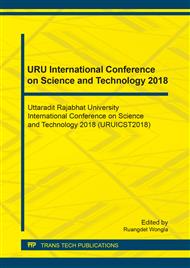[1]
G.A. Martinez-Castanon, N. Niño-Martínez, F. Martínez-Gutierrez, J.R. Martínez-Mendoza, F. Ruiz, Synthesis and antibacterial activity of silver nanoparticles with different sizes, J. Nanopart. Res. 10 (2008) 1343-1348.
DOI: 10.1007/s11051-008-9428-6
Google Scholar
[2]
N.R. Jana, L. Gearheart, C.J. Murphy, Wet chemical synthesis of silver nanorods and nanowires of controllable aspect ratio, Chem. Commun. 0 (2001) 617-618.
DOI: 10.1039/b100521i
Google Scholar
[3]
A. Travan, C. Pelillo, I. Donati, E. Marsich, M. Benincasa, T. Scarpa, S. Semeraro, G. Turco, R. Gennaro, S. Paoletti, Non-cytotoxic silver nanoparticle-polysaccharide nanocomposites with antimicrobial activity, Biomacromolecules. 10 (2009).
DOI: 10.1021/bm900039x
Google Scholar
[4]
M. Yadollahi, S. Farhoudian, H. Namazi, One-pot synthesis of antibacterial chitosan/silver bio-nanocomposite hydrogel beads as drug delivery systems, Int. J. Biol. Macromol. 79 (2015) 37-43.
DOI: 10.1016/j.ijbiomac.2015.04.032
Google Scholar
[5]
M. Bilal, T. Rasheed, H.M.N. Iqbal, C. Li, H. Hu, X. Zhang, Development of silver nanoparticles loaded chitosan-alginate constructs with biomedical potentialities, Int. J. Biol. Macromol. 105 (2017) 393-400.
DOI: 10.1016/j.ijbiomac.2017.07.047
Google Scholar
[6]
A.F. Martins, J.P. Monteiro, E.G. Bonafe´, A.P. Gerola, C.T.P. Silva, E.M. Girotto, A.F. Rubira, E.C. Muniz, Bactericidal activity of hydrogel beads based on N,N,N-trimethyl chitosan/alginate complexes loaded with silver nanoparticles, Chin. Chem. Lett. 26 (2015).
DOI: 10.1016/j.cclet.2015.04.032
Google Scholar
[7]
K.B. Narayanan, S.S. Han, Dual-crosslinked poly(vinyl alcohol)/sodium alginate/silver nanocomposite beads - A promising antimicrobial material, Food. Chem. 234 (2017) 103-110.
DOI: 10.1016/j.foodchem.2017.04.173
Google Scholar
[8]
C. Wang, X. Huang, W. Deng, C. Chang, R. Hang, B. Tang, A nano-silver composite based on the ion-exchange response for the intelligent antibacterial applications, Mater. Sci. Eng. C. 41 (2014) 134-141.
DOI: 10.1016/j.msec.2014.04.044
Google Scholar
[9]
S. Azizi, R. Mohamad, R.A. Rahim, R. Mohammadinejad, A.B. Ariff, Hydrogel beads bio-nanocomposite based on Kappa-Carrageenan and green synthesized silver nanoparticles for biomedical applications, Int. J. Biol. Macromol. 104 (2017) 423-431.
DOI: 10.1016/j.ijbiomac.2017.06.010
Google Scholar
[10]
S. Alqahtani, P. Promtong, A.W. Oliver, X.T. He, T.D. Walker, A. Povey, L. Hampson, I.N. Hampson, Silver nanoparticles exhibit size-dependent differential toxicity and induce expression of syncytin-1 in FA-AML1 and MOLT-4 leukaemia cell lines, Mutagenesis. 31 (2016).
DOI: 10.1093/mutage/gew043
Google Scholar
[11]
S. Pal, Y.K. Tak, J.M. Song, Does the antibacterial activity of silver nanoparticles depend on the shape of the nanoparticle? A study of the Gram-negative bacterium Escherichia coli, Appl. Environ. Microbiol. 73 (2007) 1712-1720.
DOI: 10.1128/aem.02218-06
Google Scholar
[12]
W.R. Li, X.B. Xie, Q.S. Shi, H.Y. Zeng, Y.S. Ou-Yang, Y.B. Chen, Antibacterial activity and mechanism of silver nanoparticles on Escherichia coli, Appl. Microbiol. Biotechnol. 85 (2010) 1115-1122.
DOI: 10.1007/s00253-009-2159-5
Google Scholar
[13]
N.P. Singh, M.T. McCoy, R.R. Tice, E.L. Schneider, A simple technique for quantitation of low levels of DNA damage in individual cells, Exp. Cell. Res. 175 (1988) 184-191.
DOI: 10.1016/0014-4827(88)90265-0
Google Scholar
[14]
C. Carlson, S.M. Hussain, A.M. Schrand, L.K. Braydich-Stolle, K.L. Hess, R.L. Jones, J.J. Schlager, Unique cellular interaction of silver nanoparticles: size-dependent generation of reactive oxygen species, J. Phys. Chem. B. 112 (2008).
DOI: 10.1021/jp712087m
Google Scholar
[15]
J. López-García, M. Lehocký, P. Humpolíček, P. Sáha, HaCaT keratinocytes response on antimicrobial atelocollagen substrates: Extent of cytotoxicity, cell viability and proliferation, J. Funct. Biomater. 5 (2014) 43-57.
DOI: 10.3390/jfb5020043
Google Scholar
[16]
Y.J. Kim, S.I. Yang, J.C. Ryu, Cytotoxicity and genotoxicity of nano-silver in mammalian cell lines, Mol. Cell. Toxicol. 6 (2010) 119-125.
DOI: 10.1007/s13273-010-0018-1
Google Scholar


